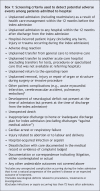Impact of patient communication problems on the risk of preventable adverse events in acute care settings
- PMID: 18519903
- PMCID: PMC2396356
- DOI: 10.1503/cmaj.070690
Impact of patient communication problems on the risk of preventable adverse events in acute care settings
Abstract
Background: Up to 50% of adverse events that occur in hospitals are preventable. Language barriers and disabilities that affect communication have been shown to decrease quality of care. We sought to assess whether communication problems are associated with an increased risk of preventable adverse events.
Methods: We randomly selected 20 general hospitals in the province of Quebec with at least 1500 annual admissions. Of the 145,672 admissions to the selected hospitals in 2000/01, we randomly selected and reviewed 2355 charts of patients aged 18 years or older. Reviewers abstracted patient characteristics, including communication problems, and details of hospital admission, and assessed the cause and preventability of identified adverse events. The primary outcome was adverse events.
Results: Of 217 adverse events, 63 (29%) were judged to be preventable, for an overall population rate of 2.7% (95% confidence interval [CI] 2.1%-3.4%). We found that patients with preventable adverse events were significantly more likely than those without such events to have a communication problem (odds ratio [OR] 3.00; 95% CI 1.43-6.27) or a psychiatric disorder (OR 2.35; 95% CI 1.09-5.05). Patients who were admitted urgently were significantly more likely than patients whose admissions were elective to experience an event (OR 1.64, 95% CI 1.07-2.52). Preventable adverse events were mainly due to drug errors (40%) or poor clinical management (32%). We found that patients with communication problems were more likely than patients without these problems to experience multiple preventable adverse events (46% v. 20%; p = 0.05).
Interpretation: Patients with communication problems appeared to be at highest risk for preventable adverse events. Interventions to reduce the risk for these patients need to be developed and evaluated.
Figures




Comment in
-
Health literacy and harm: who is at risk? What is the fix?CMAJ. 2008 Jun 3;178(12):1573-4. doi: 10.1503/cmaj.080628. CMAJ. 2008. PMID: 18519906 Free PMC article. No abstract available.
References
-
- Davis P, Lay-Yee R, Briant R, et al. Adverse events in New Zealand public hospitals. I: occurrence and impact. N Z Med J 2002;115:U271. - PubMed
-
- Thomas EJ, Studdert DM, Burstin HR, et al. Incidence and types of adverse events and negligent care in Utah and Colorado. Med Care 2000;38:261-71. - PubMed
-
- Wilson R, Runciman WB, Gibberd RW, et al. The quality in Australian Health Care Study. Med J Aust 1995;163:458-71. - PubMed
Publication types
MeSH terms
LinkOut - more resources
Full Text Sources
Medical
